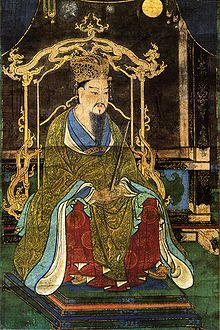Kammu
Kammu ( Japanese 桓 武天皇 , Kammu-tennō ; * 737 in Heijō-kyō (today Nara ), † April 9, 806 in Heian-kyō (today Kyoto )) was the 50th Tennō of Japan . His reign lasted from 781 to 806. He was the son of Kōnin -tennō. His mother came from a Korean clan. His birth name was Prince Yamabe.
He was the father of Heizei -tennō, Saga -tennō and Junna -tennō. The Taira clan descends from him.
government
Kammu's accession to the throne (at the comparatively old age of 45) did not meet with undivided approval in court circles. Your main argument against it was that his mother Takano no Niigasa , the wife of Kōnins , came from a family of Korean ( Baekje ) and thus non-Japanese origin. Through him the ruling branch of the dynasty (beginning with Temmu 672-86) since the Jinshin Civil War was ousted. His main supporter was Fujiwara no Momokawa .
He was known for his assertiveness. The campaigns against the Emishi in the north fall under his rule . The necessary almost general conscription, with simultaneous frequent droughts and famines, led to uprisings.
He founded capitals twice. First 784 Nagaoka-kyō , the construction of which was canceled after 10 years. The reasons for this can be found in Nihon Ryoiki (III, 38): “The flight and resettlement of the stars of heaven was a sign of the resettlement of the Heavenly Majesty's residence in the following year, a year Earth-below-Taurus (785), in autumn On the night of the 15th month, the whole night the moon's face became black, it lost its light, the sky darkened. In the same month on the 23rd day (January 1st, 786) at the hour of the boar, the third straight rank Minister of the Office of the Rites Fujiwara no Tanetsugu ( 藤原 種 継 ) in the island street of the Nagaoka residence was shot by the Life Guard ... " His brother Prince Sawara ( 早 良 ) Kammus, Konin's second son and Crown Prince, was involved in the murder of Tanetsugu and was banished to Awaji . However, Sawara died on the way there. Later in the 7th month 800 he was honored as Sudō Tennō ( 崇 道 天皇 ) because his spirit haunted the imperial family and the Fujiwara .
Then 794 Heian-kyō (today Kyōto). Here he had the famous Butokuden training facility built. He sent the Buddhist monks Kūkai and Saichō to the Chinese Empire , who after their return founded the Japanese branches of Tendai and Shingon Buddhism.
Sakanoue no Tamuramaro was a general at the time.
literature
- Ronald P. Toby: Why Leave Nara? Kammu and the Transfer of the Capital. In: Monumenta Nipponica . Vol. 40, No. 3. S 331-347.
| predecessor | Office | successor |
|---|---|---|
| Konin |
Tennō 781-806 |
Heating egg |
| personal data | |
|---|---|
| SURNAME | Kammu |
| ALTERNATIVE NAMES | Kanmu; 桓 武天皇 (Japanese) |
| BRIEF DESCRIPTION | 50th Tennō of Japan (781-806) |
| DATE OF BIRTH | 737 |
| PLACE OF BIRTH | Nara |
| DATE OF DEATH | April 9, 806 |
| Place of death | Heian-kyō |
